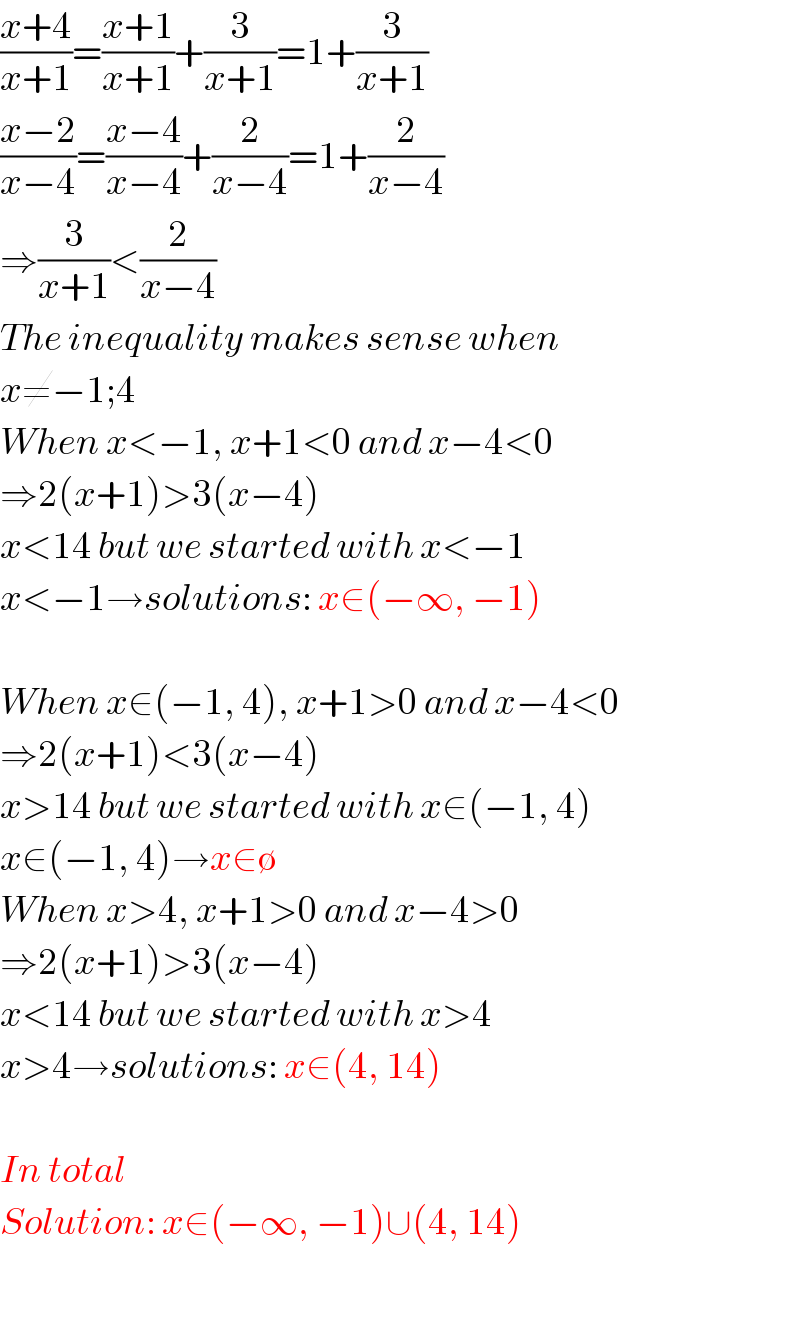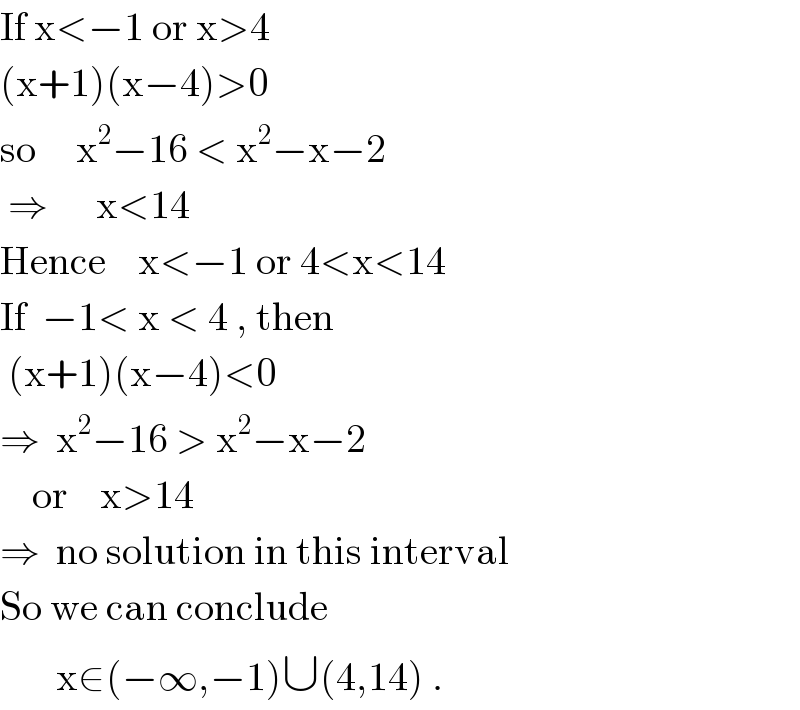
Question Number 18342 by mondodotto@gmail.com last updated on 19/Jul/17

Answered by alex041103 last updated on 19/Jul/17

$$\frac{{x}+\mathrm{4}}{{x}+\mathrm{1}}=\frac{{x}+\mathrm{1}}{{x}+\mathrm{1}}+\frac{\mathrm{3}}{{x}+\mathrm{1}}=\mathrm{1}+\frac{\mathrm{3}}{{x}+\mathrm{1}} \\ $$$$\frac{{x}−\mathrm{2}}{{x}−\mathrm{4}}=\frac{{x}−\mathrm{4}}{{x}−\mathrm{4}}+\frac{\mathrm{2}}{{x}−\mathrm{4}}=\mathrm{1}+\frac{\mathrm{2}}{{x}−\mathrm{4}} \\ $$$$\Rightarrow\frac{\mathrm{3}}{{x}+\mathrm{1}}<\frac{\mathrm{2}}{{x}−\mathrm{4}} \\ $$$${The}\:{inequality}\:{makes}\:{sense}\:{when} \\ $$$${x}\neq−\mathrm{1};\mathrm{4} \\ $$$${When}\:{x}<−\mathrm{1},\:{x}+\mathrm{1}<\mathrm{0}\:{and}\:{x}−\mathrm{4}<\mathrm{0} \\ $$$$\Rightarrow\mathrm{2}\left({x}+\mathrm{1}\right)>\mathrm{3}\left({x}−\mathrm{4}\right) \\ $$$${x}<\mathrm{14}\:{but}\:{we}\:{started}\:{with}\:{x}<−\mathrm{1} \\ $$$${x}<−\mathrm{1}\rightarrow{solutions}:\:{x}\in\left(−\infty,\:−\mathrm{1}\right) \\ $$$$ \\ $$$${When}\:{x}\in\left(−\mathrm{1},\:\mathrm{4}\right),\:{x}+\mathrm{1}>\mathrm{0}\:{and}\:{x}−\mathrm{4}<\mathrm{0} \\ $$$$\Rightarrow\mathrm{2}\left({x}+\mathrm{1}\right)<\mathrm{3}\left({x}−\mathrm{4}\right) \\ $$$${x}>\mathrm{14}\:{but}\:{we}\:{started}\:{with}\:{x}\in\left(−\mathrm{1},\:\mathrm{4}\right) \\ $$$${x}\in\left(−\mathrm{1},\:\mathrm{4}\right)\rightarrow{x}\in\emptyset \\ $$$${When}\:{x}>\mathrm{4},\:{x}+\mathrm{1}>\mathrm{0}\:{and}\:{x}−\mathrm{4}>\mathrm{0} \\ $$$$\Rightarrow\mathrm{2}\left({x}+\mathrm{1}\right)>\mathrm{3}\left({x}−\mathrm{4}\right) \\ $$$${x}<\mathrm{14}\:{but}\:{we}\:{started}\:{with}\:{x}>\mathrm{4} \\ $$$${x}>\mathrm{4}\rightarrow{solutions}:\:{x}\in\left(\mathrm{4},\:\mathrm{14}\right) \\ $$$$ \\ $$$${In}\:{total} \\ $$$${Solution}:\:{x}\in\left(−\infty,\:−\mathrm{1}\right)\cup\left(\mathrm{4},\:\mathrm{14}\right) \\ $$$$ \\ $$
Answered by ajfour last updated on 19/Jul/17

$$\mathrm{If}\:\mathrm{x}<−\mathrm{1}\:\mathrm{or}\:\mathrm{x}>\mathrm{4} \\ $$$$\left(\mathrm{x}+\mathrm{1}\right)\left(\mathrm{x}−\mathrm{4}\right)>\mathrm{0} \\ $$$$\mathrm{so}\:\:\:\:\:\mathrm{x}^{\mathrm{2}} −\mathrm{16}\:<\:\mathrm{x}^{\mathrm{2}} −\mathrm{x}−\mathrm{2} \\ $$$$\:\Rightarrow\:\:\:\:\:\:\mathrm{x}<\mathrm{14} \\ $$$$\mathrm{Hence}\:\:\:\:\mathrm{x}<−\mathrm{1}\:\mathrm{or}\:\mathrm{4}<\mathrm{x}<\mathrm{14} \\ $$$$\mathrm{If}\:\:−\mathrm{1}<\:\mathrm{x}\:<\:\mathrm{4}\:,\:\mathrm{then} \\ $$$$\:\left(\mathrm{x}+\mathrm{1}\right)\left(\mathrm{x}−\mathrm{4}\right)<\mathrm{0} \\ $$$$\Rightarrow\:\:\mathrm{x}^{\mathrm{2}} −\mathrm{16}\:>\:\mathrm{x}^{\mathrm{2}} −\mathrm{x}−\mathrm{2} \\ $$$$\:\:\:\:\mathrm{or}\:\:\:\:\mathrm{x}>\mathrm{14} \\ $$$$\Rightarrow\:\:\mathrm{no}\:\mathrm{solution}\:\mathrm{in}\:\mathrm{this}\:\mathrm{interval} \\ $$$$\mathrm{So}\:\mathrm{we}\:\mathrm{can}\:\mathrm{conclude} \\ $$$$\:\:\:\:\:\:\:\mathrm{x}\in\left(−\infty,−\mathrm{1}\right)\cup\left(\mathrm{4},\mathrm{14}\right)\:. \\ $$
